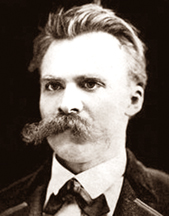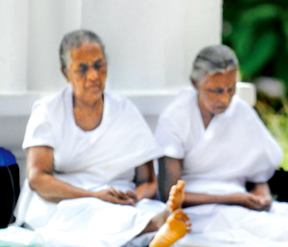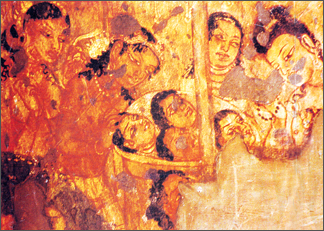|
Buddhist Spectrum
Friedrich Nietzsche under the Buddhist spectrum
Dr Ruwan M Jayatunge
In the consciousness of the truth he has perceived, man now sees
everywhere only the awfulness or the absurdity of existence . . . and
loathing seizes him. – Friedrich Nietzsche
Friedrich Nietzsche (1844-1900) a German philosopher is considered as
one of the significant free thinkers in the history. Nietzsche was a
“naturalist who believed that nothing more than nature exists.
Naturalism has invaded every area of human culture. Naturalists do
not believe in the supernatural. Therefore divinity is not a viable
option for the naturalists. If man is in need of salvation, he will have
to save himself. Buddhism promotes this idea.
|

Friedrich Nietzsche |
Human capacity to ask “why” is one thing that makes us distinct as
human beings. The primary component of a world view relates to the
question “what exists. People understand the importance of the question
“who am I?” Because we are conscious of our existence, we naturally ask
such questions.
What does it mean to be a human being? We form beliefs about whether
or not there is a spiritual aspect to our nature. The prince Siddhartha
renounced his wealth and power in search of these truths.
World views are commonly defined by reference to the “reality”
category. Naturalism, then, is a world view founded on some beliefs
about nature. It is the belief that only the natural realm exists.
Naturalistic world views include atheism, scientism, secular humanism,
existentialism and nihilism.
Postmodernism is also heavily influenced by naturalism A naturalistic
view of human existence includes an awareness of the transitory state of
life. The existentialists deny the very existence of the omnipotent God.
Dostoevsky once stated If God didn’t exist, everything would be
possible.”
In the universe of material objects, any attempt to erect an ethical
system is, by definition, arbitrary fiction. For naturalists, ethical
judgments are expressions of emotion. The ancient Greek philosopher
Pytogoras was the first to espouse humanism in his famous dictum, “Man
is the measure of all things.”
Humanistic optimism is echoed in the famous words of John F. Kennedy,
“All of mans problems have been created by man and can be solved by
man.” The naturalistic view of reality is closely related to the nature.
Since man is only a biological entity, knowledge is based on
physical, sense experience. The sciences become the final arbiter of
truth in the naturalistic world view. Atheism is the naturalistic view
of reality. The naturalists consider that the life is pragmatic: seeking
wisdom and liberation are necessary.
The Buddhist view is somewhat different from Friedrich Nietzsche’s
understanding. The Buddhist world view is ‘naturalist in the sense that
it rejects explanations based on the concepts of God and soul or any
concepts working as substitutes.
Buddhist notions of nature reveal insights into the nature of nature’
Buddhists perceives the world on four levels: existentially, morally,
cosmologically, and ontologically.
Buddhism has developed a comprehensive theory of the nature of
nature, encompassing all aspects of it and applying concepts of great
depth and breadth to its analysis. All objects and conditions are
regarded as being in a continuous state of change. Nothing finite is
eternally fixed or unchanging.
Friedrich Nietzsche wanted to answer the reasons for human
suffering. Nietzsches arguments concur that human beings are supposed to
undergo suffering. Does human suffering have meaning? The existential
realization of the universality of suffering lies at the core of the
Buddha’s teaching.
He praised Buddhism for setting out to treat suffering as opposed to
sin, but believed the treatment itself represented a surrender of life,
and ultimately a weaker response to the human condition than his own.
Nietzsche’s interpretation of Buddhism is a life-negating philosophy
that seeks to escape an existence dominated by suffering.
Buddhas view of reality—everything is interrelated but nothing has a
stable essence. Nietzsche also has the answer to life that seems
suffering. His answer, which is expressed in the same book of
Zarathustra, is an attitude towards life that helps one overcome the
feeling of its meaninglessness. It starts with the idea that life is an
eternal recurrence with no beginning and no end but a repetition of the
very same life over and over again.
The emptiness is the human condition to which both Buddhism and
Nietzsche respond. Nietzsche saw nihilism as the outcome of repeated
frustrations in the search for meaning.
Nietzsche was interested in early Buddhism, he believed that Buddhism
was superior to many beliefs in its psychological insight and understood
its attraction for the West, but still considered it a form of passive
nihilism.
The Buddha rejected both extremes of eternalism and nihilism. Buddha
believed that nihilist view of existence is considered false because it
is based on incomplete understanding of reality. Buddha did not teach
annihilation after death.
‘Nihilism and emptiness have two different meanings. Nihilism means
that nothing really exists and emptiness means that nothing has
independent existence. Nietzsche saw nihilism as the outcome of repeated
frustrations in the search for meaning. He diagnosed nihilism as a
latent presence within the very foundations of European culture.’
What is meditation? - an investigation
The word meditation is a much used word these days, covering a wide
range of practices. In Buddhism it designates two kinds of meditation –
one is called ‘samatha’, the other ‘vipassana’, Samatha meditation is
one of concentrating the mind on an object , rather than letting it
wander off to other things. One chooses an object such as the sensation
of breathing, and puts full attention on the sensations of the
inhalation and exhalation.
Eventually through this practice you begin to experience a calm mind
– and you become tranquil because you are cutting off all other
impingements that come through the senses.
|

Meditation heals distress |
The objects that you use for tranquility are tranquillising (needless
to say!). If you want to have an excited mind, then go to something that
is exciting, don’t go to a Buddhist monastery, go to a disco......
Excitement is easy to concentrate on, isn’t it? It’s so strong a
vibration that it just pulls you right into it. You go to the cinema and
if it is really an exciting film, you become enthralled by it. You don’t
have to exert any effort to watch something that is very exciting or
romantic or adventurous. But if you are not used to it, watching a
tranquillising object can be terribly boring.
What is more boring than watching your breath if you are used to more
exciting things? So for this kind of ability, you have to arouse effort
from your mind, because the breath is not interesting, not romantic, not
adventurous or scintillating – it is just as it is. So you have to
arouse effort because you’re not getting stimulated from outside.
In this meditation, you are not trying to create any image, but just
to concentrate on the ordinary feeling of your body as it is right now:
to sustain and hold your attention on your breathing. When and concepts
we create around sensory experience.
Much of our life is based on wrong assumptions made through not
understanding and not really investigating the way anything is. So life
for one who isn’t awake and aware tends to become depressing or
bewildering, especially when disappointments or tragedies occur. Then
one becomes overwhelmed because one has not observed the way things are.
In Buddhist terms we use the word Dhamma, or Dharma, which means ‘the
way it is’, ‘the natural laws.’ When we observe and ‘practise the Dhamma,’
we open our mind to the way things are.
In this way we are no longer blindly reacting to the sensory
experience, but understanding it, and through that comprehension
beginning to let go of it. We begin to free ourselves from just being
overwhelmed or blinded and deluded by the appearance of things.
Now to be aware and awake is not a matter of becoming that way, but
of being that way. So we observe the way it is right now, rather than
doing something now to become aware in the future.
It follows the laws of nature, of creation and destruction, of being
born and then dying. Anything that is born doesn’t stay permanently in
one state, it grows up, gets old and then dies. All things in nature,
even the universe itself, have their spans of existence, birth and
death, beginning and ending. All that we perceive and can conceive of is
change; it is impermanent. So it can never permanently satisfy you.
In Dhamma practice, we also observe this unsatisfactoriness of
sensory experience. Now just note in your own life that when you expect
to be satisfied from sensory objects or experiencer you can, you do
that, the breath becomes more and more refined, and you calm down..... I
know people who have prescribed samatha meditation for high blood
pressure because it calms the heart.
So this is tranquility practice. You can choose different objects to
concentrate on, training yourself to sustain your attention till you
absorb or become one with the object. You actually feel a sense of
oneness with the object you have been concentrating on, and this is what
we call absorption.
The other practice is ‘vipassana’, or ‘insight meditation.’ With
insight meditation you are opening the mind up to everything. You are
not choosing any particular object to concentrate on or absorb into, but
watching in order to understand the way things are.
Now what we can see about the way things are, is that all sensory
experience is impermanent. Everything you see, hear, smell, taste,
touch, all mental conditions – your feelings, memories and thoughts –
are changing conditions of the mind, which arise and pass away. In
vipassana, we take this characteristic of impermanence (or change) as a
way of looking at all sensory experience that we can observe while
sitting here.
This is not just a philosophical attitude or a belief in a particular
Buddhist theory: impermanence is to be insightfully known by opening the
mind to watch, and being aware of the way things are. It’s not a matter
of analysing things by assuming that things should be a certain way and,
when they aren’t, then trying to figure out why things are not the way
we think they should be. With insight practice, we are not trying to
analyse ourselves or even trying to change anything to fit our desires.
In this practice we just patiently observe that whatever arises passes
away, whether it is mental or physical.
We observe the body as it is, sitting here. It all belongs to nature,
doesn’t it? The human body belongs to the earth, it needs to be
sustained by the things that come out of the earth. You cannot live on
just air or try to import food from Mars and Venus. You have to eat the
things that live and grow on this Earth. When the body dies, it goes
back to the earth, it rots and decays and becomes one with the earth
again.
Buddhist Art of India
Rohan L. Jayetilleke
The excavations of Harappa and Mohendo-jaro of the Indus Valley
civilization (both sites in Pakistan territory), brought to light metal
figurines, metal slabs with pictures of a one-horned animal, and tree,
pearls, beads and ladies ornaments, foundations of multi-storied
buildings, drainage systems indicated that India was in the Iron Age,
5000 B.C. when this Iron Age was not known to any other country.
The art of Buddhism is one of the most gentle and serene in the world
and a great contribution to the development of human civilization and
culture. Writing of this great heritage by writers of the present day
are neither biased or an attempt to glorify India in the manner of the
baker’s dozen (baker’s dozen is not twelve
|

Ajantha murals - a scene from a Jataka story |
but thirteen) but to give an insight to the readers at large, how and
why Buddhist art of India contributed to create human being to be more
humane in all respects and to promote equanimity (upekkha) as regards
the process of cultural development of Indians as well as Buddhists of
other countries.
The grace and composure of Buddhist paintings, architecture and
sculpture remind us that there is an end to the sorrow of the world, in
the manner Lord Buddha 2558 years ago endowed the human race. The four
great Buddhist pilgrimage circuit of India are the sites of Lumbini,
Buddhagaya (Bihar State), Saranath and Kushinagar/Kusinara (both in
Uttar Pradesh) are not revered places for the Buddhists the world over
which aggregate to around 396 million at the moment.
Emperor Asoka of the 3rd century, was the first great royal patron of
Buddhism, surpassing the kings of the time of the Buddha like Bimbisara,
Ajasatta and Pasenadi of the 6th century B.C. Asoka built 84,000 stupas
having opened seven of the eight stupas enshrining the sacred relics of
the Buddha, a few months after the Great Demise of the Buddha having
obtained their share of the sacred relics from Braham Dona, at
Makutabandhana-cetiya in Kushinagar, after the ceremonial cremation of
the Buddha. The stupa built by the Sajayans in Rangram (in Nepal) during
Asoka’s time was in the custody of Naga kings, as the Sakyans had ceased
to exist after the massacre by Vidhudhaba, the illegitimate son of king
Pasenadi in the last year of Buddha, refused permission to Asoka to open
their stupa.
The remnents of this stupa are still seen in Nepal, at Ramgram.
Additionally Asoka built magnificent pillars with edicts all over the
country with beautiful capitals, like those of Saranath Lion Capital,
Vaishali, and Sankassa. Further he had rock and minor rock edicts too in
the country giving direction of the Indians to follow the path of Dhamma,
as taught by the Buddha three centuries prior to his reign.
With the end of the Asokan period, the 2nd century B.C. saw another
stupendous and magnificent phase of Buddhist art in the sculptured
reliefs of the railings of the huge stupas of Bharhut and Sanchi (Madhya
Pradesh). These gave a new dimension to Buddhist thoughts and also to
Indian culture, for the first time, depicting scenes from the life of
the Buddha and his previous lives as Bodhisatva as narrated in the 554
Jataka stories.
However, the Buddha was not depicted in human form, but by a wheel,
empty throne, stupa or the Bodhi Tree. The figures in the reliefs of
Bharhut, with lines flowing gracefully gave voice to the voiceless
reliefs. There is in these reliefs a sense of the lyrical, unending
melody of life of the Indian Buddhists at the time.
The railings of the stupa at Sanchi in Madhya Pradesh about 20 miles
from the capital of the state Bhopal, present the overflowing activity
of life of the then Indians. In the figures of Bharut are single spaces
between the figures, but, the Sanchi reliefs give the tumulous life,
with large group of figures in a variety of poses and outburst of frolic
some and vital existence. The diagonal movement of the figures depict
them bursting out of the boundaries. Which too indicates they free
themselves from the confined spaces in the reliefs. This is the natural
way of the humans freeing themselves from rage-old traditions.
The main stupa at Sanchi has four gateways, highly embellished with
sculptures. The Eastern Gateway has an inscription which says the
carvings were done by ‘Dantakarins (Ivory engravers), and no person
shall have these removed to another place, or claim to be theirs and
such persons will be subjected to one of the great heinous crimes and
executed. This gateway also has a caring, depicting Sanghamitta theri
bringing the southern branch for planting at Anuradhapura followed by a
royal procession.
Buddha Pradeepa 2010
The Daily News will be publishing the Buddha Pradeepa annual this
year too coinciding with Vesak Poya. Readers are invited to contribute
articles confined to 800 words addressed to:
Daily News Buddha Pradeepa 2010, No. 35, D. r. Wijewardene Mawatha,
Colombo 13.
Email:[email protected]
Closing date for articles is March 10.
Buddhism in the eyes of intellectuals...
A cosmic religion:
The religion of the future will be a cosmic religion. It should
transcend a personal God and avoid dogmas and theology. Covering both
the natural and the spiritual, it should be based on a religious sense
arising from the experience of all things, natural and spiritual, as a
meaningful unity. Buddhism answers this description. - Albert Einstein |



